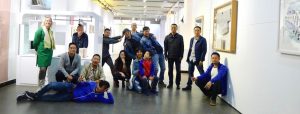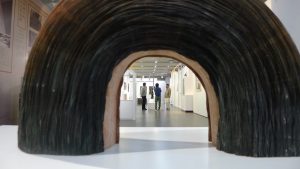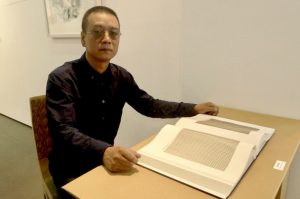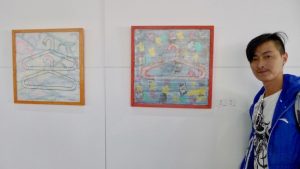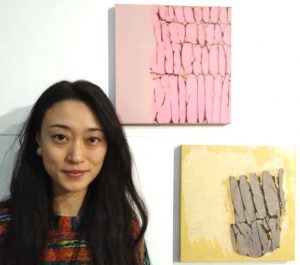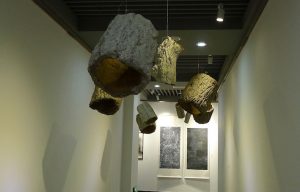Paper : Supreme is currently showing at the Ordos Culture and Arts Centre, Inner Mongolia. The exhibition continues to September 28th 2017.
Having long been the medium that carried and spread ancient traditional culture , paper is also used in Chinese language as an adjective about life ‘Life like paper’ is used as a rather melancholic term to refer to the ups and downs of existence.
‘Compared to other media, art on paper tends to be more direct , it is both concise and immediate. Paper also permeates a national identity .’said curator Chang Feng (长风). ‘On the other hand paper has this interesting randomness, a non-functionality and incompleteness which opens up a huge conversation’
Gratitude is also extended to Mr Xièbǎozhōng (谢宝忠) of KinYinBa who supported and hosted the exhibition. Thank you also to Mr He(贺) for facilitating the details of this project. This is an exhibition that explores all dimensions of paper and some unexpected facets of the material . For a quick overview of a portion of this collection I will present what the artists themselves say about their work.
lǐhóngjūn李红军
What the artist says :
I am interested in combining a plural form of paper cutting to construct a language representation of single-frame slices. Usually we start from the outside shape and work our way inside, such as the outline of a painting or the edge of a sculpture. With this single frame we can create shapes from the inside out . And then there is this other value of art language…. the positive and negagative… the with and without, the inside and outside, the position and opportunity, blocking and crossing, restraint and freedom” And then there is the spirituality of language which is the internal force of contemporary art shaping the original concept to give a model for an effective way of thinking .
What the artist says :
“My aim is to create absurd parallel worlds on paper, where good and evil coexist . The hidden process of life is a delicate blend of life and death revealing a truth… such as humble sands in the wind or a flower indulged in sweetness , such are the traces of life .
Liúbǎolín 刘宝林
What the artist says:
“This is an early work from 10 years ago. The line landscapes are made with carpenter fountain pen. The process starts out with a struggle and a lot of agitation but then becomes more rational and quiet . I think this orderly calm is my subconscious.
Fion Gunn 飞扬
What the artist says:
I first visited China in 2003 and was fascinated by a trip on the three gorges. As a child in the family antique shop I used to play with Chinese landscape and boat ornaments carved in stone or Ivory. Sailing through the gorges I felt as though I had returned to the landscape of my childhood. I did not complete this work until 6 years after that first visit because I had to ‘sail’ through the emotional journey in order to express it.
Lǐjiārui 李家瑞
What the artist says:
Hangers are born naked and have no choice but bear whichever clothes, ugly or beautiful, that are put on them. Likewise, people, in many cases, have to deal with things that are forced on them. Deep inside, we are still naked, we are who we are.
lǐ qiāng 李枪
What the artist says:
‘Stripping pages, images and words is no longer the reality of this world and my knowledge and experience end here. Civilization is a layer of skin, the basis of the world I can touch. The truth needs to be found and built, to destroy images with images, to build meaning with memory, to turn a book into a letter, to transform the wasteland into a tree, and to look at the images and fragments that face each other. The reef of memory pushes the water to the shore countless times, and I tear the world to pieces.’
Wángxiàojīn 王笑今
What the artist says:
I use the People’s Daily newspaper as my medium for painting and the stories on the paper which I specifically use all refer to the periods and events of the Cultural Revolution.
sūn kǎn孙侃
What the artist says:
I explore the strangeness of self. I am interested in pushing that strangeness to its extremities, creating a new identity a different version of oneself.
Zhāngtíngqún 张庭群
What the artist says:
Today when we look at an image we have to resort a plausible reference where we can cognitively assess this particular form. In order to determine the distance between us and them and these coordinates then we understand that it is perception, the ‘experience’ is more than aesthetics, not just knowledge, but a life-like spiritual patch that enable a full and balanced life.
sūn kǎn孙侃
Wángnányí 王南怡
What the artist says:
The control of the fire and water can be considered the same , both can take advantage of its characteristics but neither has complete control. In the five elements of nature in China, fire and water coexist both antagonistically and in harmony. So the use of fire and the use of water is a shared substance.
Jiāyóu guāng 贾有光
What the artist says:
Everyday the artwork faces a different person. The so called art is always facing their own.
Lǐhóngbō 李洪波
What the artist says:
My work began based on the traditional folk art of the paper gourd. The continuity of paper is an important element of language expression , the stretch , the gathers , the ups and downs can speak to the viewer of potential and unpredictable or even absurd landscapes. Where the outside of the sculpture can look like a wood bark surface such as here or a washed pebble but that seemingly smooth surface may contain up to ten thousand layers of paper.
Niamh Cunningham 瑞莲
What the artist says:
The ‘Feng Huang Walk’ imagery is based on an artist group residency a few years ago where the whole team visited the scenic Phoenix City (Feng Huang). The abstracted figures my fellow artists at that time are crossing the steps on the river. Although this painting does not fit into any of the Chinese painting categories yet it was made using Chinese materials , based on my working experience here in China and applying a technique which I acquired during that residency in Zhangjiajie.
Zhèng yuán wú 郑元无
What the artist says:
My work is based on the principles of Onism and I explore the practise of primitive imagery in graffiti based art.
The next post will take a look at different visits and tours with the artists around Ordos , including great photos of the Ordos desert, the Ordos grasslands, Mr Xièbǎozhōng ‘s(谢宝忠)museum of printing, fountain shows and more .
